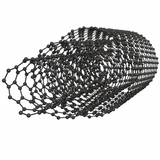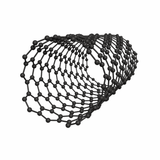Carbon Nanotubes (CNTs)

Carbon nanotubes (CNTs) are nanoscale, hollow tubes composed of covalently bonded carbon atoms. They belong to the unique class of materials called nanomaterials. CNTs are typically one carbon atom thick in one or more spatial dimensions and can be visualized as a sheet of graphene rolled into a cylindrical tube. The carbon atoms in CNTs are arranged in the same hexagonal structure as in graphene.
Since their discovery in 1991, carbon nanotubes have captivated the scientific community with their extraordinary properties. Today, you can transform your research with our range of single, double, and multi-walled nanotubes.
Features and Applications
- With unique structures and dimensional constraints, CNTs exhibit exceptional mechanical, electrical, thermal, and optical properties.
- From semiconductors and chemical sensors to field emission devices and environmental pollution remediation, the potential uses for our CNTs are vast and varied.
- Carbon nanotubes demonstrate electrical carrying capacities up to 1000 times that of copper wires, making them ideal for electronic systems and supercapacitors.
- With carboxylic acid (-COOH) and hydroxyl (-OH) functionalized CNTs, enhancing properties like dispersibility in solvents and biochemical functionality without altering the unique properties of the inner tubes is easy.
Browse Carbon Nanotubes
Related categories: low dimensional materials, nanodots and quantum dots, 2D materials
Filter by functionalization:
Learn More
 What are Multi-Walled Carbon Nanotubes?
What are Multi-Walled Carbon Nanotubes?
Multi-walled carbon nanotubes (MWCNTs) consist of multiple carbon nanotubes nested within one another. The carbon nanotubes are just one atom thick and this gives MWCNTs unique electrical and mechanical properties.
Learn more... What are Single-Walled Carbon Nanotubes (SWCNT)?
What are Single-Walled Carbon Nanotubes (SWCNT)?
Single-walled carbon nanotubes (SWCNTs) are sheets of graphene that have been rolled up to form a long hollow tube, with wall thickness of a single atom. Their one-dimensional structure gives them extraordinary mechanical, electrical and thermal properties.
Learn more... What's the difference between SWCNT and MWCNT?
What's the difference between SWCNT and MWCNT?
Single-walled carbon nanotubes (SWCNTs) and multi-walled carbon nanotubes (MWCNTs) have some similarities and some key differences. Both materials are made from hexagonal lattices of carbon, specifically graphene sheets rolled up to form tubular structures. However, the nested structure of MWCNTs gives them distinct properties that differentiate them from SWCNTs.
Learn more... The Properties of Carbon Nanotubes
The Properties of Carbon Nanotubes
Carbon nanotubes (CNTs) have unique properties such as high conductivity and strength. They have similar properties to another carbon allotrope known as graphene. This is due to the similarity in structure of 2D sheet-like graphene and 1D carbon nanotubes which are essentially cylindrical tubes of rolled up graphene.
Learn more... How are Carbon Nanotubes Made?
How are Carbon Nanotubes Made?
There are multiple methods for producing carbon nanotubes (CNTs) and they usually involve gas phase processing. The three key methods are; chemical vapor deposition (CVD), laser ablation and arc discharge.
Learn more... Carbon Nanotubes vs Graphene: Structure, Properties and Uses
Carbon Nanotubes vs Graphene: Structure, Properties and Uses
Carbon nanotubes (CNTs) and graphene are two ground-breaking nanomaterials composed entirely of carbon atoms. Both are allotropes of carbon where atoms are bonded in a hexagonal lattice.
Learn more... What is a Carbon Nanotube Battery?
What is a Carbon Nanotube Battery?
Carbon nanotubes (CNTs), such as single-walled carbon nanotubes (SWCNT), have been tipped as one of the most exciting nanomaterials in the development of battery technology. The key properties of CNTs that make them ideal candidates as battery components is their high electron conductivity, high strength and lightweight nature.
Learn more... The Different Types of Carbon Nanotubes
The Different Types of Carbon Nanotubes
The two main types of carbon nanotubes are single-walled carbon nanotubes (SWCNT) and multi-walled carbon nanotubes (MWCNT). Scientific research has led to the development of other types of carbon nanotubes with distinct features. Modifications to the chemistry and structure of carbon nanotubes have improved specific properties for various applications.
Learn more...References and Reading
- Iijima, S (1991). Helical microtubules of graphitic carbon. Nature 354, 56–58. https://doi.org/10.1038/354056a0
- Paradise, M., & Goswami, T. (2007). Carbon nanotubes – Production and industrial applications. Materials & Design, 28(5), 1477–1489. https://doi.org/10.1016/J.MATDES.2006.03.008
- Kong, J., Franklin, N. R., Zhou, C., Chapline, M. G., Peng, S., Cho, K., & Dai, H. (2000). Nanotube molecular wires as chemical sensors. Science, 287(5453), 622–625. https://doi.org/10.1126/SCIENCE.287.5453.622/ASSET/9184CD8F-DEA6-49E7-B27E925BFD69D5F4/ASSETS/GRAPHIC/SE0208199004.JPEG












